| کد مقاله | کد نشریه | سال انتشار | مقاله انگلیسی | نسخه تمام متن |
|---|---|---|---|---|
| 4574213 | 1629510 | 2011 | 8 صفحه PDF | دانلود رایگان |

Climate change is expected to increase the intensity of precipitation, but our ability to model the consequences for soil respiration are limited by a lack of data from soils that are saturated and draining. In this study, we used large intact soil columns (28 × 30 cm) to 1) quantify changes in CO2 flux as soils drain from saturated conditions, and 2) to determine which soil water metrics best predict instantaneous maximum CO2 flux. The columns were from three agricultural landscape positions that vary in soil properties. We simulated water table fluctuations that were observed at the field site (and predicted to increase in future climate scenarios) by flooding the columns from bottom to surface and then allowing the columns to drain for 96 h while monitoring volumetric soil water content (VWC), water filled pore space (WFPS), water content normalized to field capacity, matric potential, and CO2 flux. Mean cumulative CO2 flux was 4649 mg CO2―C m− 2 96 h− 1. Regardless of landscape position, CO2 flux rates exhibited a single maximum slightly below saturation, near field capacity. This result suggests that many field studies have not captured soil respiration rates when water availability is optimum for heterotrophic respiration. Across landscape positions, matric potential was the most consistent indicator of instantaneous maximum CO2 flux, with maximum fluxes occurring within the narrow range of − 0.15 to − 4.89 kPa. In contrast, instantaneous maximum CO2 flux rates occurred between 95 and 131% of water content normalized to field capacity, 72–97% WFPS, and 29–45% VWC. Thus, our data suggest that instantaneous maximum CO2 flux rates, a key parameter in ecosystem models, can be predicted across an agricultural landscape with diverse soils if matric potential is used as a water scalar.
Research highlights
► Climate change is expected to increase the intensity of precipitation, but our ability to model the consequences for soil respiration are limited by a lack of data from soils that are saturated and draining.
► We used large intact soil columns (28 × 30 cm) that varied in soil properties to determine soil water metrics that best predict instantaneous maximum CO2 flux.
► Soil water metrics included: volumetric soil water content, water filled pore space, water content normalized to field capacity and matric potential.
► CO2 flux rates exhibited a single maximum below saturation that occurred near field capacity and within a narrow range of matric potential (− 0.15 to − 4.89 kPa) regardless of soil properties.
► Our data suggest that instantaneous maximum CO2 flux rates, a key parameter in ecosystem models, can be predicted across agricultural landscapes with diverse soils if matric potential is used as a water scalar.
Journal: Geoderma - Volume 162, Issues 3–4, 15 May 2011, Pages 273–280